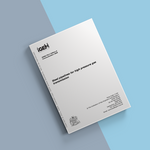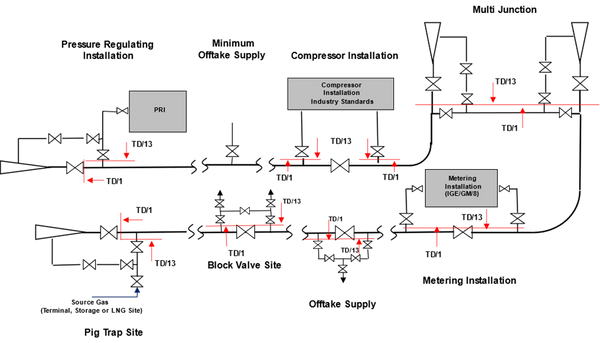IGEM/TD/1 Edition 6 with amendments May 2024 - Steel pipelines for high pressure gas transmission

Synopsis of IGEM/TD/1 Edition 6 with amendments May 2024:
This Standard supersedes Edition 6, Communication 1848, published in 2021. It has been approved by the Gas Transmission and Distribution Committee (GTDC) and published by the authority of the Council of IGEM.
This standard contains information on the construction, operation and maintenance of onshore steel pipelines used for the large-scale transmission of natural gas. It also applies to some associated installations e.g. above-ground valves.
The standard covers the design, construction, inspection, testing, operation and maintenance of steel pipelines and certain associated installations for the transmission of dry natural gas, with or without odorisation, at MOP exceeding 7 bar and not exceeding 100 bar.
It may be appropriate for use with other gases but the characteristics and consequential effect upon design, material, operations and maintenance of the pipeline must be taken into account.
It covers operating temperatures between -25°C and +120°C and applies to pipelines laid between points on land, including water crossing. If a pipeline has an offshore part, additional guidance may be required for that section, though many of these requirements will remain valid. It equally applies to pipework design for certain associated installations, including above-ground valves, pig trap installations, manifolds, multi-junction stations, the main pipework at compressor stations, metering installations, connections and other off takes. It does not apply for PRIs.
Specifically, it details:
-
Management systems
-
Planning and legal considerations
-
Materials and component selections
-
Pipeline design, including sizing, thickness, stress calculation, fatigue, area types, sleeving, valves and pigging
-
Construction, including safety and environmental measures, welding, bedding and covering, backfilling and crossing
-
Testing, including equipment, planning, acceptance criteria, safety and repair
-
Commissioning
-
Protection against corrosion
-
Associated installations, including site layout and selection, design, construction and testing
-
Operation and maintenance, including surveillance and inspection
Introduction
i) Scope applies to steel pipelines operating at pressures exceeding 7 bar.
ii) Associated installations are transferred to TD/13 Edition 3.
Note: It is the owner’s and/or the designer’s responsibility to select the standard and standard sections which most appropriately apply to the connection of an associated installation to a pipeline.
iii) Pressure terms and criteria to align with IGEM/TD/13 and BS EN 1594, including design pressure (DP), maximum operating pressure (MOP) and maximum incidental pressure (MIP) are included.
iv) Pipeline MOP shall not exceed any prescribed design pressure and it shall not exceed the maximum working pressure of any component.
Note: A class rating or PN rating can define a component’s maximum working pressure or MOP at the pipeline maximum operating temperature.
v) New Type H area is defined as an S area subject to creeping developments resulting in a population density greater than 30 persons per hectare. Where a new development is planned or occurs in such an area, a safety evaluation as described in Sub-Sections 2.1 and 6.8 is required.
vi) High-density polyethylene (HDPE) slabs are allowed for protection against third party damage.
vii) Requirements for Affirmation of MOP are revised to:
a. confirm measures to detect and control external interference
b. clarify the procedure for raising the pressure to the MOP to be applied where the pipeline has operated at more than 7 bar below the declared MOP for a period exceeding 5 consecutive years.
1.5 Engineering requirements are set out for the safe design, construction, inspection, testing, operation and maintenance of pipelines in accordance with current knowledge.
This Standard is intended to protect from possible hazards members of the public and those who work with pipelines, as well as the environment, so far as is reasonably practicable. It is also intended to ensure that the security of gas supply is maintained.
1.6 This Standard is applicable to conditions normally encountered in the transmission of gas. Additional design considerations may be necessary where unusual conditions are encountered. These may include unstable ground (including the possibility of mining subsidence), mechanical or sonic vibrations, long self-supported spans, massive special attachments or thermal forces other than seasonal.
Note: Some guidance on dealing with subsidence is provided in Section 6.
1.7 This Standard makes use of the terms “must”, “shall” and “should” when describing particular requirements. Notwithstanding Sub-Section 1.9:
- the term “must” identifies a requirement by law in Great Britain (GB) at the time of publication
- the term “shall” prescribes a requirement which, it is intended, will be complied with in full and without deviation
- the term “should” prescribes a requirement which, it is intended, will be complied with unless, after prior consideration, deviation is considered to be acceptable
Such terms may have different meanings when used in Legislation, or Health and Safety Executive (HSE) Approved Codes of Practice (ACoPs) or guidance, and reference needs to be made to such statutory Legislation, ACoPs or official guidance for information on legal obligations.
1.8 It is now widely accepted that the majority of accidents in industry generally are in some measure attributable to human as well as technical factors. People who initiated actions that caused or contributed to the accidents might have acted in a more appropriate manner to prevent them.
To assist in the control of risk and proper management of these human factors, due account is be taken of HSG48 and HSG65.
1.9 The primary responsibility for compliance with legal duties relating to health and safety at work rests with the employer. The fact that certain employees, for example “responsible engineers”, are allowed to exercise their professional judgement does not allow employers to abrogate their primary responsibilities. Employers must:
- have done everything to ensure, so far as is reasonably practicable, that there are no better protective measures that can be taken other than relying on the exercise of professional judgement by “responsible engineers”
- have done everything to ensure, so far as is reasonably practicable, that “responsible engineers” have the skills, training, experience and personal qualities necessary for the proper exercise of professional judgement
- have systems and procedures in place to ensure that the exercise of professional judgement by “responsible engineers” is subject to appropriate monitoring and review
- not require “responsible engineers” to undertake tasks which would necessitate the exercise of professional judgement that is beyond their competence. There should be written procedures defining the extent to which “responsible engineers” can exercise their judgement. When “responsible engineers” are asked to undertake tasks that deviate from this, they should refer the matter for higher review.
Note: The responsible engineer is a suitably qualified, competent and experienced engineer appointed to be responsible for the execution and for approval of activities associated with the design, construction, operation and maintenance of pipelines.
1.10 Notwithstanding Sub-Section 1.7, this Standard does not attempt to make the use of any method or specification obligatory against the judgement of the responsible engineer. Where new and better techniques are developed and proved, they should be adopted without waiting for modification to this Standard. Amendments to this Standard will be issued when necessary and their publication will be announced in the Journal of IGEM and other publications as appropriate.
1.11 Requests for interpretation of this Standard in relation to matters within its scope, but not precisely covered by the current text, to be either:
- addressed to Technical Services, IGEM, IGEM House, 26 & 28 High Street, Kegworth, Derbyshire, DE74 2DA; or
- emailed to [email protected].
and will be submitted to the relevant Committee for consideration and advice, but in the context that the final responsibility is that of the engineer concerned. If any advice is given by, or on behalf of, IGEM, this does not relieve the responsible engineer of any of their obligations.
1.12 This Standard was published in October 2021.
Scope
2.1 This Standard covers the design, construction, inspection, testing, operation and maintenance of steel pipelines and certain associated installations (see Figure 1), for the transmission of dry Natural Gas (predominantly methane), with or without odorisation, at MOP exceeding 7 bar and not exceeding 100 bar. The scope may be extended beyond MOP of 100 bar but specific areas will require further justification and documentation which embraces a safety evaluation.
While the Standard may be appropriate for use with other gases, the characteristics of the gas and the consequential effect upon design, material, operations and maintenance of the pipeline have to be taken into account. In this context, other gases are those described by 1st family, other 2nd family and 3rd family gases as defined in BS EN 437.
Note 1: Requirements for steel pipelines of MOP not exceeding 7 bar are contained in IGEM/TD/3, and on steel services in IGE/TD/4.
Note 2: A safety evaluation involves a systematic study of the major hazard potential of a pipeline and its associated installations (see Sub-Section 6.8).
2.2 This Standard covers operating temperatures between – 25 °C and + 120 °C inclusive.
2.3 This Standard applies to pipelines laid between points on land, including water crossings. For pipelines of which any part is offshore, additional or alternative guidance may be required for the offshore section. However, many of these requirements will remain valid.
Note: Offshore pipelines are those that are on the seaward side of the low water mark or special boundaries drawn at bays and estuaries.
This Standard equally applies to pipework design for certain associated installations, including buried block valves and pig trap installations. IGEM/TD/13 applies to PRIs, manifolds, multi-junction stations, the main pipework at compressor stations, metering installations, connections and other off takes.
2.4 Pressures quoted are gauge pressure, unless otherwise stated.
2.5 Appendix 2 lists Legislation, Guidance Notes, Standards etc., which are identified within this Standard, as well as further items of Legislation that may be applicable.
Where Standards are quoted, equivalent national and international Standards, etc. equally may be appropriate. Unless otherwise stated the latest version of the referenced document is to be used.
2.6 Italicised text is informative and does not represent formal requirements.
2.7 Appendices are informative and do not represent formal requirements unless specifically referenced in the main sections via the prescriptive terms “must”, “shall” or “should”.

Note 1: This diagram illustrates the interface between the design requirements of IGEM/TD/1 and IGEM/TD/13 – it does not demonstrate typical pipework arrangements.
Note 2: Additional design requirements for line valves, pig traps and overhead crossings are given in Section 6. These installations are to be tested, operated and maintained in accordance with IGEM/TD/1.
FIGURE 1 - APPLICATION OF IGEM/TD/1 EDITION 6
